Getting enough iron from plants can be challenging if we do not get the full picture of iron sources and absorption. There are some factors we need to know about getting enough iron from plants, but once we know how, it’s very well doable. This natural iron protocol helps you understand how to raise your iron intake and uptake from plants.
Keep in mind that running into iron deficiency is not uncommon, even for people on a meat-containing diet. In fact, some people report having raised their iron levels by becoming vegan. There seems to be no particular dietary “type” that cause iron deficiency, but there certainly are keys to successful iron absorption! So, let’s dive into how to get the iron we need from plants foods and raw foods:
For quick readers:
On a plant-based or high-raw diet, greens and tropical fruits provide enough iron, along with other nutrients needed to absorb the iron. However, there are some important things to know, not to mess this up! This plant-based iron protocol uses the power of fruits, greens, and herbs to get enough iron sources and enhance bioavailability. Use the power of a very high-vitamin C intake and reduce iron uptake inhibitors.
Summary of the plant iron protocol: To increase your plant iron, adopt a diet high in tropical fruits, greens, and nuts while avoiding absorption blockers like coffee and anti-nutrients!
These are iron-boosting raw foods:
- Tropical fruits and all types of berries
- Seed-containing fruits like figs and passion fruit
- Raw nuts, cashews, coconut
- Green leaves: lettuce, microgreens, spinach, herbal leaves,
- Herbal infusions
- Dried fruits, like raisins, dates, prunes, figs
To boost iron additionally to the diet you can:
- take powerful, but natural supplements: The combination of curry leave extract (usually 14 mg of iron per capsule) with a camu camu extract to reach 2000 mg of vitamin C in total (including diet).
- Avoid foods that decrease iron uptake like coffee, green tea, black tea, dairy).
But let’s dive in, why fruits are key, and how to do this right!
How much iron do we need?
Adults need to get around 8 mg (men) or 15-18 mg (women) of iron from foods daily (source). If you do not eat meat, you need 80% more, meaning approximately 14-15 mg for men and 27-32 mg a day. The main function of iron is in the blood as part of hemoglobin, providing oxygen to cells. Thus, iron is literally vital, a part of our life force!
Getting enough iron can be challenging for people on a plant-based diet because iron is not as easily obtained by our body from plants as it is from animal sources. This is especially true for women with higher iron requirements.
Here is the good news, though: we can address this issue when looking at the bigger bigger in nature and find the missing key to tackle the issue of poor plant iron bioavailability:
“…vegans are no more likely to develop iron deficiency anemia than the general population. Vegans typically consume an adequate amount of iron because their diet is high in vitamin C, which improves absorption of nonheme iron.”
WebMD.com
When taking supplements, we are advised that only a small percentage gets absorbed. So, we KNOW absorption is the biggest obstacle for iron. But there is a reason for this! We suffer from chronic vitamin C deficiency, which is the key to iron absorption. So besides asking how much iron we need, we should also ask, how much vitamin C do we need?
How much vitamin C do we need?
As weird as it sounds, iron is usually not the limiting factor to getting iron. It’s vitamin C, the pivotal vitamin for iron absorption, of which humans do not get enough via modern diets. In fact, humans, like all mammals, need around 2000-3000 mg of vitamin C daily (read more below), while recommendations lie below 100 mg for adults. The average current vitamin C intake is much too low, which explains why many struggle with getting enough iron from plants!
Drinking orange juice and eating citruses is the familiar image we get when thinking about vitamin C in our diet, and is recommended to enhance the absorption of plant iron. However, there is much more to vitamin C in our diet! The natural human diet is very high in fruits, because – like all apes – we are frugivores (see below)! This puts a new dimension and new perspective into the picture of iron absorption, too!
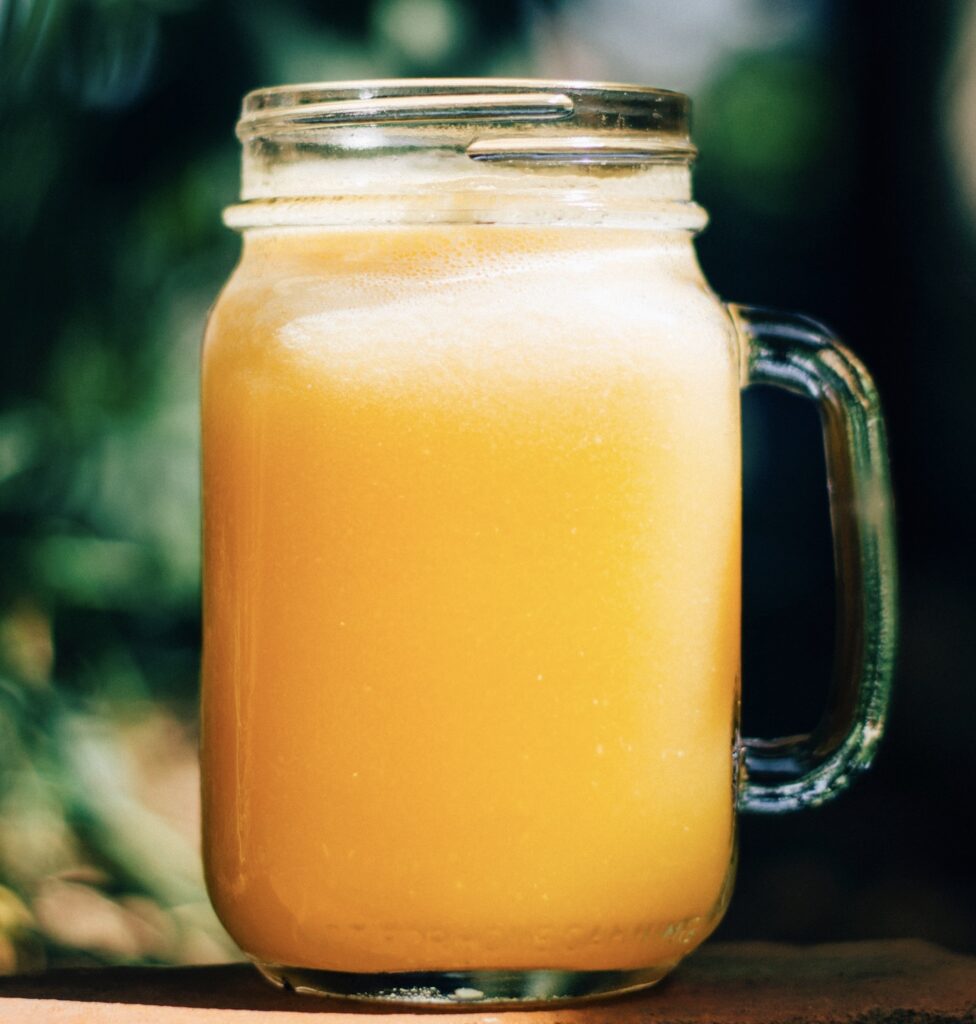
So let’s see how we get those two vital components for our body:
Plant iron and its absorption
The common perception when adopting a plant-based diet is that we need good amounts of legumes, lentils, greens, seeds, or nuts as a plant source of iron. Fruits are not perceived as important when it comes to iron, but they actually play a key role! While nuts, seeds, and greens are important foods in the natural human diet, grains, legumes, and lentils can be harsh on our digestive system and contain anti-nutrients to prevent iron absorption. For more information on heme and non-heme iron, also read our in-depth article.
There are two components to getting plant iron (non-heme iron): the actual iron source and its absorption. Absorption is affected by other foods that are either enhancers or inhibitors.
- Iron sources: which ideally has a low level of anti-nutrients and foods that help with its absorption. Bioavailable plant-based iron are herbs, leaves, and iron-rich fruits. Some iron sources are foods, and some are more readily available as supplements or infusions.
- Foods that help iron absorption: Vitamin C is the most powerful iron booster. Fruits contain many factors that help absorb iron, including vitamin C, copper and even fructose, and inulin from fruits increase iron availability. Getting enough fruits and much higher vitamin C than most humans do, is the key in this protocol – and it is actually what we should get by our natural diet (more on this topic below).
- Foods that prevent iron absorption: Iron inhibitors are a variety of compounds and anti-nutrients in plant-based and animal-based foods, like phytic acids, polyphenols, calcium, excess protein, and oxalate, which are present in many foods. The main culprits are coffee, green and black tea, and dairy, but also grains and legumes and generally plant-protective compounds. Many foods that are not part of our natural diet inhibit iron uptake.
Plant iron usually is absorbed poorly compared to animal heme iron, but the underlying issue is that we consume too many inhibitors and do not nearly get enough of vitamin C – the key iron booster!
Now we know the main missing links to successful iron uptake: Good iron sources, enough iron-absorption enhancers, and reducing the inhibitors.
How does vitamin C enhance iron uptake?
The crucial role of fruits and vitamin C in non-heme plant iron absorption has long been known. Iron builds a chelate with vitamin C in the gut, reducing ferric iron (Fe3+) to ferrous iron (Fe2+) and enhancing absorption. Ferrous iron is the form we find in animal-based, heme iron:
“Ascorbic acid is a powerful enhancer of nonheme iron absorption and can reverse the inhibiting effect of such substances as tea and calcium/phosphate. The enhancement of iron absorption from vegetable meals is directly proportional to the quantity of ascorbic acid present.”
Lynch and Cook, 1980
The true scope of the effect of insufficient vitamin C – or “fruit deficiency” – on iron uptake can only be understood when we know about the natural, fruit-rich diet of humans, similar to chimpanzees and other apes!
The natural way to get enough iron from plants
Nature is often our best teacher, especially in nutrition. Not surprisingly, we can learn how to get more iron from plant foods from our closest living relatives, the chimpanzees. The apes have very similar physiology and gut anatomy to humans. Both species are naturally frugivores, meaning their main food source is tropical fruits. Chimpanzees stick to their species-specific diet in nature, and do get all the nutrients they need from natural foods – while we humans have forgotten our natural diet due to our cooking culture, and even struggle to access high-quality foods due to the modern way of life!
How do apes get iron?
Chimpanzees (30-60 kg body weight) eat around 3-6 kilos of fruits, which contain around 10-30 grams of iron, plus around 2000 mg of vitamin C, which makes the non-heme iron highly absorbable! Meat is not a regular food or iron source for chimps or other apes. Carnivores get their iron mainly from meat, herbivores form greens, but frugivores have fruits. Not surprisingly, we find a lot of research that supports the role of vitamin C in the uptake of plant-based, non-heme iron.

Note: Nutritional requirements are known to be highly similar in humans and chimpanzees! The nutrient requirements are nearly identical, which is why the RDAs for humans are used for dietary guidelines for chimpanzees in captivity. Vice versa, studying the natural chimpanzee diet can be just as useful to understand the human natural diet.
So, let’s translate the chimps’ way of getting iron into the human diet:
Fruit and micronutrients as key to absorbing non-heme iron
And here comes the main issue we encounter with plant-based iron: The average current vitamin C intake is much too low, which explains why many struggle with getting enough iron from plants! While the recommended amount of vitamin C lies under 100 mg, humans actually need around 2000-3000 mg of vitamin C daily! To further aggregate the problem, most plant-based diets are full of anti-nutrients and iron uptake inhibitors.
There are other nutritional factors and co-factors, like magnesium, copper, zinc, and vitamin D that play a role in iron status and hemoglobin production. On the other hand, iron status affects other nutrients, like vitamin B12 and folate.
So let’s jump into details and the practical part of getting a good amount of iron from our diet:
The Fruit, Greens, and Herbs Protocol
The aim of this protocol is to strive towards a more natural, and species-specific human diet. A diet the resembles the diet of our frugivorous cousins. While the food sources of chimpanzees are wild and of a much higher quality than our food supply, nonetheless, we might just learn some things. For humans, the closest we can get to a natural diet is integrating similar foods for iron into our diet:
1. Natural Iron Sources: Herbs, leaves, and fruits
Make tropical fruits, greens, and nuts the staple foods of your diet. Fruits contain somewhere from 0.3 – 1.5 grams of iron per 100 grams. Tropical fruits and seeded fruits tend to have more than temperate fruits. While fruits can contain less than iron-rich green foods or nuts, we have to consider that we usually eat fruits in much more quantities than greens!
Tropical fruits, berries and nuts are superior iron sources
We should get a high intake of ripe, tropical fruits and raw nuts. Coconut is important in our species-specific diet! Dried fruits can be a source of concentrated nutrients and add to our iron intake if we cannot obtain enough high-quality fruits otherwise. Make sure they are free of oils and other additives!
Tropical fruits and most types of berries contain around 0.5 g of iron per 100g, while other types of fruits contain between 0.1-0.3 grams of iron (see the table below). This is because of the fundamental difference: most of those fruits have originally evolved as bird foods, and thus do not provide the nutrients that mammals (including humans) need. Tropical fruits also have a special place in human nutrition as they are primate foods and thus are the best match there can be for our body.
| Fruit | Iron content per 100 g | Iron content per serving |
|---|---|---|
| Passion fruit | 1.6 mg | 1.6 mg |
| Acai berry | 0.6 mg | 1.2 mg |
| Apricots | 0.4 mg | 0.8 mg |
| Durian | 0.4 mg | 0.8 mg |
| Strawberries | 0.4 mg | 0.8 mg |
| Blackberries | 0.6 mg | 0.6 mg |
| Dried figs | 2.0 mg | 1.0 mg |
| Raisins | 1.9 mg | 0.3 mg |
| Coconut | 2.4 mg | 1.9 mg |
| Cashew | 6.7 mg | 3.3 mg |
| Macadamia | 3.7 mg | 1 mg |
Once more, tropical fruits and berries beat other types of fruits with iron content. This is why fruits are usually not considered a significant source of iron – cause we are usually talking about temperate fruits.
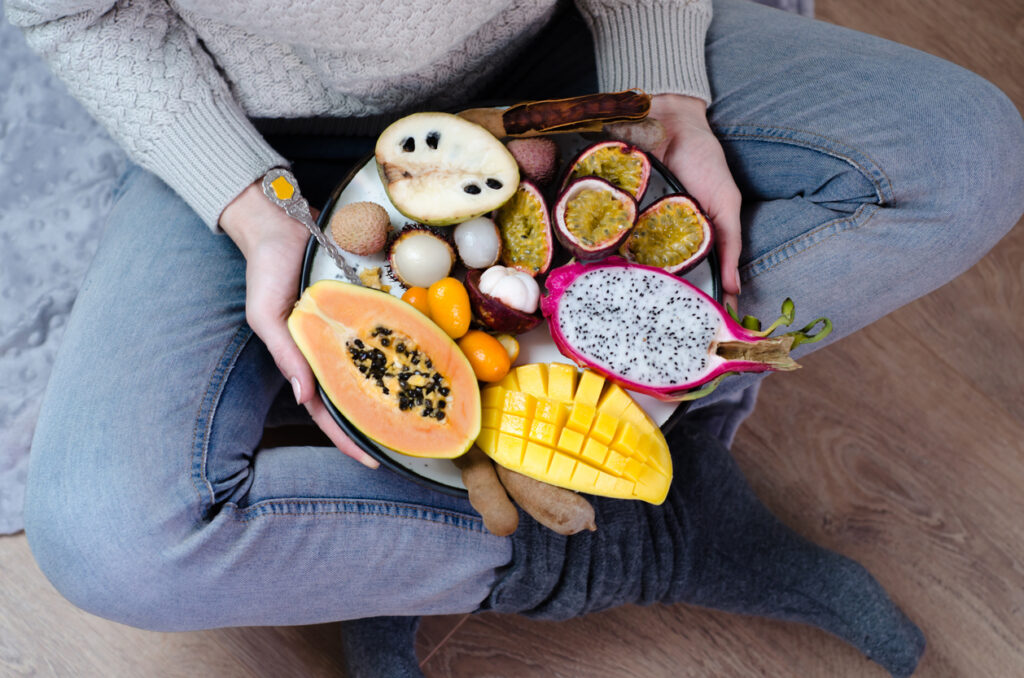
Herbs and greens as an iron source
Greens like lettuce, tender leafy greens, sprouts, and microgreens can deliver good amounts of iron because the iron is accumulated in the chloroplasts of green plant parts (mostly leaves). However, it is certainly harder to eat 200 grams of greens than eating 200 grams of fruit. Herbal infusions from iron-rich plants, like nettle tea or curry leaf extract, can deliver more iron in much less volume.
Herbs can be functional foods. Herbal capsules and herbal extracts can deliver iron like an iron supplement, but naturally.
Some greens and herbs to get irons are:
| Green / herb | Iron content |
|---|---|
| Curry leaf extract | 14 mg per capsule |
| Guava leaf tea | n/a |
| Nettle tea | 0.1 mg per cup |
| Barley grass juice powder | 21 mg per 100 g |
| Moringa powder | 53 mg per 100 g |
| Dandelion | 3 mg per 100 g |
| Green juices | 0.4 mg per 100 g |
| Microgreens | 0.75 mg per 100 g |
| Lettuce | 0.9 mg per 100 g |
Example of a raw day with over 15 mg of iron
Example of a raw day with over 15 mg of iron and 500 mg vitamin C in ca. 2000 kcal of food:
Note: those are the numbers calculated from lower-quality supermarket foods. Natural, high-quality foods would contain much more! If we add one curry leave supplement, we can reach 30 mg of iron plus a camu camu supplement we reach 2000 mg of vitamin C.
Note: Talk to your health care provider or get your iron levels checked to know your iron levels and the amount you actually need to get.
- Large açai bowl with passion-fruit and chia topping
- Handful of Brazil nuts
- 50 g cashew nuts
- 1 cup of fresh coconut
- 3 bananas
- Large salad bowl with lettuce and spinach, and herbal-citrus dressing
- Cucumber, mango, sprouts, celery and walnuts as salad topping
- 2 large mangoes
- 1 large papayas
- Jackfruit
2. Foods that help absorb iron – Absorption is key!
Eat fruits, fruits, and fruits. Especially tropical fruits.
When taking iron supplements, we are advised that only a small percentage gets absorbed. So, we KNOW absorption is the biggest obstacle for iron. But there is a reason for this! We suffer from chronic vitamin C deficiency, which is the key to iron absorption:
Non-heme iron from plants highly depends on vitamin C for its absorption (here and here)! And it’s the fruits that make all the difference. Fruits is the powerful tool of frugivorous animals (all apes) that facilitates the uptake of non-heme iron!
The main iron booster food is fruit due to vitamin C, fructose, and inulin, the nutrients that increase the bioavailability of iron! Further, vitamin C decreases our intestinal “iron blocker” hormone hepcidin. Vitamin C also counteracts the oxidative stress of free iron with its anti-oxidative effects. It’s crucial to know that the natural human diet is very high in tropical fruit and vitamin C! Much higher than most modern diets are.
Fruits are our natural source of vitamin C, and while it is nothing new that vitamin C matters in iron bioavailability, it is not common knowledge that we actually constantly fall short in this vitamin! We actually need 2000-3000 mg daily as all mammals do. Most animals have internal production of vitamin C, only frugivores have lost vitamin C production and get vitamin C from their diet alone. Humans also would get this high amount from food, if we still ate our natural, evolutionary diet, which is very high in fruits.
A diet high in tropical fruits is key for many nutritional shortfalls because tropical fruits are an integral part of the natural human diet. They are generally more nutritious than temperate fruits, and concerning iron, they provide more of the mineral and also huge amounts of vitamin C.
In today’s world, with modern food quality and restricted access to tropical fruits, it’s hard to get that amount of vitamin C. The little miracle fruit to get a vitamin C boost is camu camu, which contains between 1000 and 3000 mg of vitamin C per 100g fruit pulp (100 times more than the average fruit). They are a good supplement to meet your daily needs.
Other nutrients needed for iron uptake
Nutrients are all interdependent on some levels, as our biochemistry is a complex web of direct and indirect interactions. However, the most important nutrients in iron uptake we know are mostly found in fruits, nuts, and greens. Except for vitamin D and B12:
- Fructose and inulin: Fruits
- Copper: Fruits and nuts
- Vitamin A (or beta carotene): Orange colored-fruits
- Magnesium: Greens and fruits, coconut water
- Vitamin D: sun, light device or supplements
- Vitamin B12: supplement or perfect intestinal health (which is rare; read more here)
Foods and compounds to avoid to enhance iron absorption
Main inhibitors of plant-based iron:
- Coffee
- Dairy
- Black tea
- Green tea
- Curcumin
- Phytates
- Many polyphenols, in particular tannins
Really, avoid coffee. Or at least reduce it to a time window. For example, drink your coffee(s) until lunch, but no more after that. Then take your iron-rich foods and supplements in the afternoon or evening.
Understanding the effect of polyphenols: The properties of polyphenols can seem confusing because they are a very diverse class of molecules produced by plants as secondary metabolites. The effects of polyphenolic compounds are so manyfold because they serve many different purposes in plants. Mostly, they protect and defend the plant from being damaged or eaten (i.e., through a bitter taste), but also to attract seed dispersers (flavor and smell). Some polyphenols protect plants from toxic, oxidative stress and can do the same for us. Many polyphenols are beneficial for health, but some can also potentially be harmful. The effect of polyphenols on us often depends on the purpose and evolutionary background. Fruits coevolve with their consumers, which is why they have very low levels of defense molecules (i.e., when still unripe) but contain friendly components for the benefit of the mutualistic seed disperser. Other plant parts defend themselves from being eaten chemically with polyphenols. Learn more about different foods and their evolutionary relationship with humans here.
Why non-natural iron supplements can be risky
Getting iron is a delicate balance. Too little deprives us of life force and blood building, too much is toxic. Nature has evolved mechanisms to prevent both risks. However, we are limited by our environment. And unfortunately, we live in a degraded world. For example, it is difficult to actually find good foods to stick to our natural human diet! This is why addressing all problems with an all-natural solution is not always possible, and you need supplementing.
However, if your iron levels are too low, and you opt for supplementation of high-dosage inorganic iron, there are a few things to consider:
- Free iron causes oxidative stress. It’s toxic to overload on iron. Inorganic iron per se is toxic, creating free radicals, while iron in food is embedded within a complex food matrix, which buffers the toxic effects.
- Iron levels cannot be regulated by the usual elimination routes of the body like other minerals are, and free iron can accumulate in tissue. Iron is not easily excreted from the body only decreased by bleeding (bloodletting, menses) sweating, and shedding intestinal cells (source).
- Iron supplement increases hepcidin, a protein that protects the body from iron uptake and thus decreases iron uptake. Therefore, iron supplements can actually backfire when trying to increase iron levels! The mechanism of the body to protect from isolated iron is yet another sign that iron is toxic when taken in this way.
- Iron infusion (and even oral supplementation) can come with significant side effects.
- Hemochromatosis: Some people take up iron too effectively, which can cause a harmful iron build-up in the body (the body has very limited elimination routes for iron) easily. This genetic condition is pretty common, especially in people of northern European descendants. The mutation was beneficial for people living in cold climates with dairy-heavy diets, preventing iron deficiency, especially in women. Because hemochromatosis is a common condition, we need to be extra careful before iron supplementation and consider testing for high ferritin or hemochromatosis before taking additional iron.
Feel free to comment below; we appreciate your questions, insights, and experience with a plant-based iron protocol or with supplements.
Also, check out our fruit-based diet guide if you are interested to learn about the true evolutionary human diet.
References
- Office of dietary supplements – iron (no date) NIH Office of Dietary Supplements. Available at: https://ods.od.nih.gov/factsheets/Iron-HealthProfessional/ (Accessed: 06 September 2023).
- J. Begum (2022) Top foods high in iron for vegans. WebMD. Available at: https://www.webmd.com/diet/foods-high-iron-vegans (Accessed: 15 September 2023).
- Piskin, E. et al. (2022) ‘Iron absorption: Factors, limitations, and improvement methods’, ACS Omega, 7(24), pp. 20441–20456. doi:10.1021/acsomega.2c01833.
- Lynch, S.R. and Cook, J.D. (1980a) ‘Interaction of vitamin C and iron’, Annals of the New York Academy of Sciences, 355(1 Micronutrient), pp. 32–44. doi:10.1111/j.1749-6632.1980.tb21325.x.
- Timoshnikov, V.A. et al. (2020) ‘Redox interactions of vitamin C and iron: Inhibition of the pro-oxidant activity by deferiprone’, International Journal of Molecular Sciences, 21(11), p. 3967. doi:10.3390/ijms21113967.
- K. M. Zelman (2021) Vegan diet – foods you can and cannot eat, benefits and risks. WebMD. Available at: https://www.webmd.com/diet/vegan-diet-overview#1 (Accessed: 15 September 2023).
- Kondaiah, P. et al. (2019) ‘Iron and zinc homeostasis and interactions: Does enteric zinc excretion cross-talk with intestinal iron absorption?’, Nutrients, 11(8), p. 1885. doi:10.3390/nu11081885.
- Author unknown (2021a) Copper. Linus Pauling Institute. Available at: https://lpi.oregonstate.edu/mic/minerals/copper#:~:text=Adequate%20copper%20nutritional%20status%20is,livers%20of%20copper%2Ddeficient%20animals. (Accessed: 15 September 2023).
- Malczewska-Lenczowska, J. et al. (2018) ‘The association between iron and vitamin D status in female elite athletes’, Nutrients, 10(2), p. 167. doi:10.3390/nu10020167.
- Remacha, A.F. et al. (2015) ‘Vitamin B12 and folate levels increase during treatment of iron deficiency anaemia in young adult woman’, International Journal of Laboratory Hematology, 37(5), pp. 641–648. doi:10.1111/ijlh.12378.
- (no date) Office of dietary supplements – vitamin C. NIH Office of Dietary Supplements. Available at: https://ods.od.nih.gov/factsheets/VitaminC-HealthProfessional/#h6 (Accessed: 15 September 2023).
- B. Elliott (2023) Does too much vitamin C cause side effects? Healthline. Available at: https://www.healthline.com/nutrition/side-effects-of-too-much-vitamin-c (Accessed: 15 September 2023).
- S. Pollack, S., R.M. Kaufman, W.H. Crosby (1964) ‘Iron absorption: Effects of sugars and reducing agents’, Blood, 24(5), pp. 577–581. doi:10.1182/blood.v24.5.577.577.
- Chiu, P.-F., Ko, S.-Y. and Chang, C.-C. (2012a) ‘Vitamin C affects the expression of hepcidin and erythropoietin receptor in hepg2 cells’, Journal of Renal Nutrition, 22(3), pp. 373–376. doi:10.1053/j.jrn.2011.09.007.
- Tiekou Lorinczova, H. et al. (2022) ‘Co-administration of iron and bioavailable curcumin reduces levels of systemic markers of inflammation and oxidative stress in a placebo-controlled randomised study’, Nutrients, 14(3), p. 712. doi:10.3390/nu14030712.
- Mascitelli, L. and Goldstein, M.R. (2014) ‘Inhibition of iron absorption by polyphenols as an anticancer mechanism’, Polyphenols in Human Health and Disease, pp. 1283–1286. doi:10.1016/b978-0-12-398456-2.00097-9.
- Hano, C. and Tungmunnithum, D. (2020) ‘Plant polyphenols, more than just simple natural antioxidants: Oxidative stress, aging and age-related diseases’, Medicines, 7(5), p. 26. doi:10.3390/medicines7050026.
- Ofosu, F.K. et al. (2020) ‘New insights on the use of polyphenols as natural preservatives and their emerging safety concerns’, Frontiers in Sustainable Food Systems, 4. doi:10.3389/fsufs.2020.525810.
- Abbaspour, N., Hurrell, R. and Kelishadi, R. (2014) Review on iron and its importance for human health. Journal of research in medical sciences : the official journal of Isfahan University of Medical Sciences. Available at: https://www.ncbi.nlm.nih.gov/pmc/articles/PMC3999603/ (Accessed: 15 September 2023).
- Department of Health & Human Services (2003) Iron. Better Health Channel. Available at: https://www.betterhealth.vic.gov.au/health/conditionsandtreatments/iron# (Accessed: 15 September 2023).
- Moretti, D. et al. (2015) ‘Oral iron supplements increase hepcidin and decrease iron absorption from daily or twice-daily doses in iron-depleted young women’, Blood, 126(17), pp. 1981–1989. doi:10.1182/blood-2015-05-642223.
- Hereditary hemochromatosis (2022) Centers for Disease Control and Prevention. Available at: https://www.cdc.gov/genomics/disease/hemochromatosis.htm#:~:text=What%20is%20hemochromatosis%3F,and%20organs%20and%20lead%20to (Accessed: 15 September 2023).


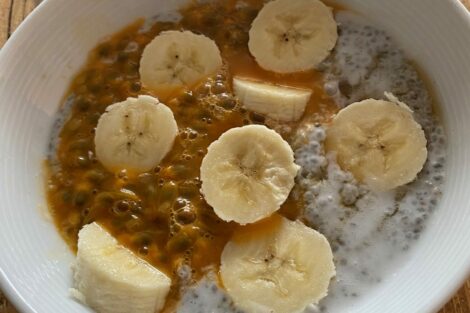
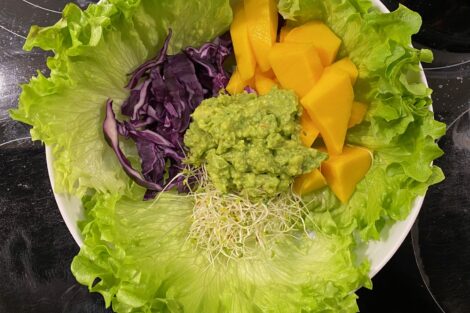
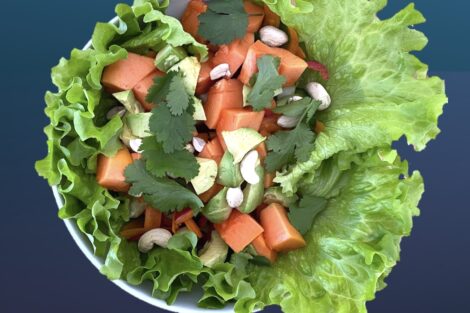
Add Comment